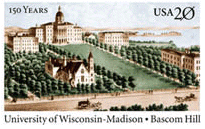

20c University of Wisconsin - Madison. Issued February 5, 1999 in Madison, Wisconsin. This postal card commemorates the 150th anniversary of the founding of the University of Wisconsin-Madison in 1849. Bascom Hall is one of the 15 major buildings on College Hill, in what is called the Bascom Hill Historic District. The district was entered into the National Register of Historic Places on Sept. 12, 1974. The illustration is a reproduction of an 1879 lithograph of the campus.
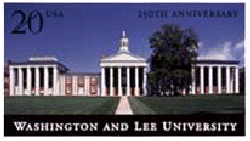 20c Washington and Lee University 250th Anniversary,
multicolored, lithographed, was issued February 11, 1999 in Lexington, Virginia.
20c Washington and Lee University 250th Anniversary,
multicolored, lithographed, was issued February 11, 1999 in Lexington, Virginia.
"The Washington and Lee University Postal Card will serve as a lasting reminder of this great university's educational excellence, which has endured from Colonial times to the present day," said Mary S. Elcano, Postal Service Senior Vice President and General Counsel, who unveiled the postal card at a meeting of the Washington and Lee Board of Trustees held at the Library of Congress.
Founded in 1749, Washington and Lee University is the sixth oldest institution of higher learning in the U.S. The university was named in 1871 for George Washington, who contributed to its endowment in 1796, and for Robert E. Lee, who served as its president from 1865 until his death in 1870.
Designed by Derry Noyes of Washington, DC, the 20-cent Washington and Lee University Postal Card is a 1999 addition to the Historic Preservation series. It features a reproduction of a photograph of the Colonnade, taken by Washington and Lee staff photographer Patrick Hinely. The neo-classical Colonnade is a group of buildings on the campus which is listed on the National Register of Historic Places.
Washington and Lee University's 200th anniversary was celebrated on April 12, 1949, with the issuance of a 3-cent commemorative postage stamp.
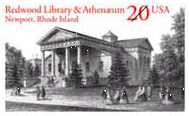
20c Redwood Library & Athenĉum. Issued March 11, 1999 in Newport, Rhode Island. This postal card commemorates the 250th anniversary of the Redwood Library and Athenĉum of Newport, Rhode Island. The Redwood Library is the oldest lending library in the country, and the original building, which was added to the National Register of Historic Places in 1966, is the oldest library building in the U.S. The anniversary celebration began Aug. 24, 1997, and continues through 2000, marking the following anniversaries: 1747 (granting of the charter), 1748-49 (construction and collection years) and 1750 (opening). The Redwood Library and Athenĉum is named after Abraham Redwood, who generously contributed to the purchase of books for the library. Designed by Peter Harrison, the building is considered by architectural historians to be one of the most significant surviving public buildings of the Colonial period. The postal card features a reproduction of a black-and-white engraving of the library from the book Views of Newport, published circa 1871 by Thomas Nelson & Sons. The engraver is unknown.
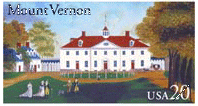
20c Mount Vernon Estate and Gardens issued May 14, 1999 at Mount Vernon, Virginia. This postal card honors historic Mount Vernon, the home and burial site of George Washington, located adjacent to the Potomac River in Mount Vernon, Virginia. 1999 is the 200th anniversary of Washington's death. In 1751, Washington inherited Mount Vernon, which became his preferred residence from 1759 until his death. Designed by Richard Sheaff, the postal card depicts the mansion house, reproduced from a detail from the National Gallery of Art painting A View of Mount Vernon, circa 1792. The artist of the painting is unknown.
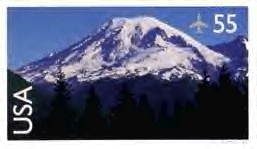
55c Mount Rainier was issued May 15, 1999 in Denver, Colorado.

20c Rock Island Light House. A commemorative stamped postal card depicting Rhode Island's historic Block Island Southeast Lighthouse, the highest lighthouse in New England, was issued July 24, 1999, during a breathtaking ceremony on the grounds surrounding the lighthouse, overlooking the sea 200 feet below. A double reply card of this design (with two 20c cards) was issued November 10, 1999
"The Block Island Southeast Lighthouse Stamped Card pays tribute to this historic landmark and recognizes the spirit of the people who raised the necessary funds to save the lighthouse from years of soil erosion," said Deborah K. Willhite, Postal Service Senior Vice President, Government Relations, who dedicated the stamped card. Block Island is surrounded by dangerous shoals and ledges, and was sometimes called the "stumbling block" of the New England coast. Dozens of vessels sank near the island in the years before the lighthouse service decided to build two lighthouses, the Block Island North Light in 1829, and the Block Island Southeast Light, first operated on February 1, 1875. The Block Island Southeast Lighthouse was designated a primary seacoast aid to navigation, which meant it was equipped with the most powerful lighting apparatus available, a $10,000 first-order Fresnel lens. The other seacoast lights in the area were Gay Head Light, Sankaty Head Light and Montauk Point Light. In 1990 the Coast Guard deactivated the Block Island Southeast Light, and began using an automated steel tower instead. By the early 1990s, 115 years of soil erosion had put the lighthouse on the endangered list; the lighthouse, once more than 300 feet from the edge of the Mohegan Bluffs, was only 55 feet from destruction. In 1990 and 1991 the National Trust for Historic Preservation listed it as one of America's 11 most endangered structures of historic significance in the United States.
The Block Island Southeast Lighthouse Foundation and other groups of volunteers raised funds to move the lighthouse back some 245 feet, to a point of safety. The lens was relighted on August 27, 1994, and the historic lighthouse is once again in service as an aid to navigation.
Designed by Derry Noyes of Washington, D.C., and illustrated by Wendell Minor of Washington Green, Conn., the stamped card depicts the Block Island Southeast Lighthouse, which is attached to the groundskeeper's residence on Mohegan Bluffs.

Set of five 20c Trains, issued August 26, 1999 in Cleveland, Ohio. Sold in a book of 20 (four each of five designs) for $6.95.
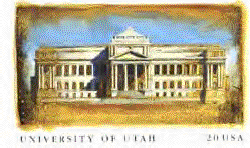
20c University of Utah, was issued February 28, 2000 in Salt Lake City, Utah. This stamped card commemorates the 150th anniversary of the founding of the University of Utah on Feb. 28, 1850. Originally named the University of Deseret, it was the first university established west of the Missouri River. Artist Allen Garns of Mesa, Ariz., depicted the neoclassical John R. Park Building on the stamped card. Completed in 1914, the Park Building is one of several historic buildings located around Presidents Circle. The Park Building was placed on the National Register of Historic Places on April 20, 1978.
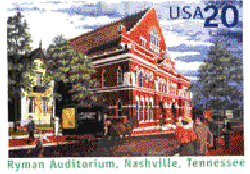
20c Ryman Auditorium was issued March 18, 2000 in Nashville, Tennessee. Ryman Auditorium, originally called the Union Gospel Tabernacle, is best known as a former home of the Grand Ole Opry. Construction of the tabernacle began in 1889 by Captain Thomas Ryman. Upon his death in 1904, it was renamed Ryman Auditorium. From the early 1940s until 1974, Ryman Auditorium was home to the Grand Ole Opry. Hank Williams, Minnie Pearl, Roy Acuff, Tammy Wynette and many other country musicians performed there during this time. Before the Grand Ole Opry came to the Ryman, the building had served as a place for religious meetings, conventions, lectures, operas, theatrical performances, concerts and other events. It was placed on the National Register of Historic Places in May 1971. After renovation in 1994, Ryman Auditorium reopened as a theater. The stamp art features an original oil painting by Mike Summers. The painting, completed in 1994, now hangs in the Ryman Auditorium. It depicts how the building looked around the turn of the century when it housed the Union Gospel Tabernacle.
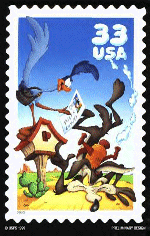
20c Wile E. Coyote and Road Runner, issued April 26, 2000 in Phoenix, Arizona. The event marks not only the first time a U.S. stamp has been dedicated on-line, but also the first time consumers can purchase stamps via the Internet on the first day of issue. Traditionally, first day of issuance ceremonies are held in a single city and the stamps made available exclusively in that location for one day.
Wile E. Coyote has appeared in more than 40 cartoons with Road Runner, the speedy object of his appetite. Wile E. Coyote is a lovable antihero. His confidence and ambition never cease in his pursuit of the elusive Road Runner who, relying on an instinctive gift for survival, effortlessly thwarts all his schemes. Warner Brothers' beloved animation director Chuck Jones invented Wile E. Coyote and the Road Runner as two tireless adversaries on a never-ending chase. Legendary animation director Chuck Jones created the ultimate cartoon rivals when they debuted in their first animated short, "Fast and Furry-ous." He based Wile E. Coyote's adept skill with various apparatuses and contraptions upon his own experiences as an unaccomplished handyman. Jones then partnered the Wile E. Coyote with the Road Runner, whose modus operandi is to deliver a well-timed "Beep! Beep!", unfurl his tongue and speed blithely by, eluding Wile E. Coyote and all of his failed Acme Products. The unconventional chase has become a classic in cartoon history.

20c Adoption, issued May 10, 2000, in Los Angeles, California. The cards were issued in a pack of 10 for $6.95.
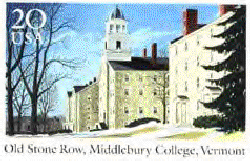
20c Middlebury College, this stamped postal card commemorating the 200th anniversary of Middlebury College was issued May 19, 2000, in Middlebury, Vermont. The charter for the college was officially granted November 1, 1800, and classes began five days later. Middlebury College is the oldest operating institution of higher education in Vermont and the second oldest in terms of charter. It is a private liberal arts college that enrolls some 2,000 students in a rigorous academic program. The stamped card features a painting by Arnold Holeywell of the east side of Old Stone Row.

20c The Stars and Stripes, issued June 14, 2000, in Baltimore, Maryland. This series of 20 postcards were issued in conjunction with a pane of similar stamps. The stamp pane pays tribute to the American flag and its unique history. Composed of 20 different flags, the series loosely charts the evolution of the Stars and Stripes from colonial times to the present. Among the flags displayed are the Continental Colors and the Star-Spangled Banner, in addition to many regional and military flags. These flags were selected for their significance in American history as well as for their aesthetic value. The beauty of the postcards is based on the diversity of the designs combined with the theme of red, white and blue. In order to achieve visual continuity, the red and blue colors were standardized.
For more information on stamps and stamp-related products, visit the Postal Services Web site and click "Stamps."

